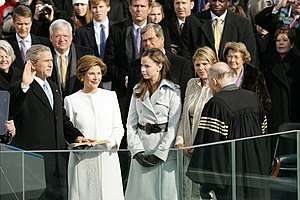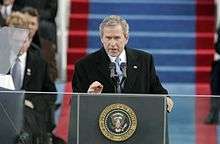Second inauguration of George W. Bush
 George W. Bush takes the oath of office for his second term. | |
| Date | January 20, 2005 |
|---|---|
| Location |
Washington, D.C. U.S. Capitol |
| Participants |
President of the United States, George Walker Bush William Hubbs Rehnquist Richard Bruce Cheney |


The second inauguration of George W. Bush as President of the United States took place on Thursday, January 20, 2005. The inauguration marked the beginning of the second term of George W. Bush as President and Dick Cheney as Vice President. Ailing Chief Justice William Rehnquist administered the Oath of office for the last time before his death in September 2005. Attendance at the inauguration has been reported as being around 100,000,[1] 300,000,[2] or 400,000.[3]
Speech
Bush's inaugural address, delivered in 21 minutes, centered on and expanded upon previous foreign policy remarks concerning the promotion of democracy around the world, as well as making human rights the guiding principle of US foreign policy.[4] According to William Safire, Bush had told his chief speechwriter, Michael Gerson, "I want this to be the freedom speech."[5]
America's vital interests and our deepest beliefs are now one. From the day of our Founding, we have proclaimed that every man and woman on this earth has rights, and dignity, and matchless value, because they bear the image of the Maker of Heaven and earth. Across the generations we have proclaimed the imperative of self-government, because no one is fit to be a master, and no one deserves to be a slave. Advancing these ideals is the mission that created our Nation. It is the honorable achievement of our fathers. Now it is the urgent requirement of our nation's security, and the calling of our time. So it is the policy of the United States to seek and support the growth of democratic movements and institutions in every nation and culture, with the ultimate goal of ending tyranny in our world.
And later:
Today, America speaks anew to the peoples of the world: All who live in tyranny and hopelessness can know: the United States will not ignore your oppression, or excuse your oppressors. When you stand for your liberty, we will stand with you. Democratic reformers facing repression, prison, or exile can know: America sees you for who you are: the future leaders of your free country.
Combined, the speech used the words "free," "freedom," and "liberty" 49 times.[4]
Inaugural Parade
During the parade there were some protests along the route, but these were after the address and supporters far outnumbered the protesters. President Bush and the First Lady, Laura Bush, left their bullet-proof limousine and walked some of the route.
Security
As the first presidential inauguration after the September 11 attacks, security was tighter than previous ceremonies. The inaugural parade route as well as other related sites were guarded by 13,000 police and soldiers, in addition to aerial patrols by helicopter and fighter aircraft and rooftop sharpshooters. In downtown Washington, a 100 square block area was closed to traffic.[4]
Protests
Many protested at the ceremonies and five people were arrested during the inauguration ceremony.[6]
Protestors worked to block access to the actual swearing in ceremony. Tickets were given out only by state senators and representatives, and a few RNC officials. Ticketholders, who were from all over the country, were advised not to bring backpacks or bags, and were told such items wouldn't be allowed through security. Protestors obtained tickets, and then brought large bags to the event, clogging security checkpoints. Rather than directing all bag holders to one security screening line, security officials allowed the lines to be clogged, preventing many people from entering the secured area to view/hear President Bush and Vice-President Cheney. Protesters standing in line cheered the success of their actions, and were quite pleased that they denied people the opportunity to see the ceremony.
See also
References
- ↑ Jemal R. Brinson, "INAUGURATION 2009: Where history will be made", The Atlanta Journal-Constitution, January 18, 2009. Last accessed January 22, 2009.
- ↑ Angela Greiling Keane and Chris Dolmetsch, "Washington Braces for Chaos, Gridlock at Inaugural (Update1)" Bloomberg.com, January 18, 2009. Last accessed January 22, 2009.
- ↑ "Official Inauguration crowd estimate: 1.8 million", CNN Political Ticker, January 22, 2009, Last accessed January 22, 2009.
- 1 2 3 Baker, Peter; Fletcher, Michael A. (2005-01-21). "Bush Pledges to Spread Freedom". Washington Post. Retrieved 2009-01-23.
- ↑ Safire, William (2005-01-21). "Bush's 'Freedom Speech'". The New York Times. Retrieved 2009-01-23.
- ↑ "Bush: Expand freedom 'in all the world'" CNN, January 21, 2005. Last accessed January 22, 2009.
External links
| Wikimedia Commons has media related to George W. Bush 2005 presidential inauguration. |
| Wikisource has original text related to this article: |

